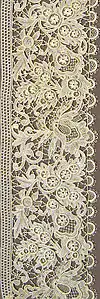Lacemaking in Croatia
Lacemaking in Croatia (Croatian: Čipkarstvo u Hrvatskoj) is a tradition dating back to the Renaissance when lacemaking began spreading throughout the Mediterranean[1] and continental Europe. Throughout the years, Croatian lace has become notable for its unique patterns and designs. In 2009, UNESCO recognised lacemaking in Croatia as an Intangible Cultural Heritage of Humanity.[2]
| Klapa multipart singing of Dalmatia, southern Croatia | |
|---|---|
 Lace from Pag | |
| Country | Croatia |
| Reference | 245 |
| Region | Europe and North America |
| Inscription history | |
| Inscription | 2009 (4th session) |
Today in Croatia, there are several centres of lacemaking tradition, most notably the Adriatic islands of Pag and Hvar, the northern town of Lepoglava, and the Sveta Marija village in the Međimurje County.
Notable lace

Pag: needle lace
Pag lace is made by needle-point and consists of spider web pattern embellishments and numerous geometrical motifs. The finished product is very firm, and unlike other Croatian laces, can be washed.
Lace in Pag is still made today in the traditional fashion from centuries ago, and a school has opened to keep the lacemaking tradition alive.[3]
Lepoglava: bobbin lace

Lepoglava lace is a closely worked bobbin lace, with its structure consisting of a combination of stylized geometric, floral, and animal motifs and patterns. A flax or cotton thread is used, always in the color white, and comes in various shapes and sizes.
Lacemaking in Lepoglava began production in the late 19th century, reaching its "Golden Age" between the two World Wars.[4] During this time, the lace won many competitions at international exhibitions: in Paris 1937 it won a gold medal, and two years later it won a bronze in Berlin.[5] This era was one of great prosperity for Lepoglava lace.
An international lace festival is held in Lepoglava every year in September in honour of the town's lacemaking culture.[6]
Hvar: agave or aloe lace
Hvar lace is unique in that the thread is collected from the aloe leaves of agave plants that grow on the island.[7] The leaves are picked at a certain time of the year and are then specially processed to produce a thin, white thread.
The Benedictine nuns in the town of Hvar are the only ones who make the Hvar lace, which is also called "aloe lace".[8]
See also
References
- "Lacemaking in Croatia; DOCUMENTS: Nomination for inscription on the Representative List in 2009". UNESCO. 2009-09-28. Retrieved 2011-11-28.
- http://www.unesco.org/culture/ich/index.php?pg=00011&RL=00245
- HGK: Pag lace Archived 2012-04-26 at the Wayback Machine
- Miroslav Gašparović & Marina Bagarić: Hidden treasure of the Museum of Arts and Crafts, Zagreb: selection from the museum holdings to mark the 125th anniversary of MUO. Zagreb, 2005. p211
- Povijest čipke Archived 2011-11-08 at the Wayback Machine
- 15th International Lace Festival, Lepoglava 2011 Archived 2011-12-05 at the Wayback Machine
- United States Institute for Theatre Technology. "TD & T" , Volume 43, Issues 2-4, 2007.
- The Lace from Hvar Archived 2012-04-26 at the Wayback Machine
External links
- Lacemaking in Croatia (Video) at kultura.hr, Croatian Cultural Heritage project, Ministry of Culture of the Republic of Croatia
- Lacemaking in Croatia: UNESCO
